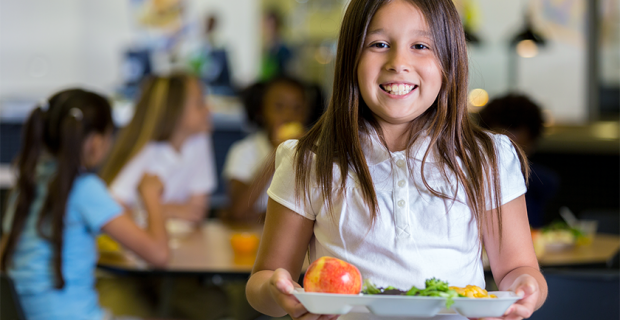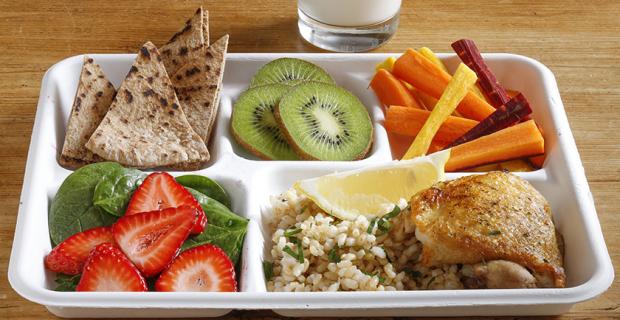This Student Has a Bold Vision for the Future of School Meals

Anahi Nava Flores is a student at Mt. Diablo Unified School District. The district has been a member of the Center for Ecoliteracy’s California Food for California Kids® Network since 2015. Anahi is a school board member and leads the student advisory committee and social justice club. In a recent Associated Press article on the district’s efforts to improve school meals, Anahi shared, “Serving this on a regular basis demonstrates and proves to us as students that we’re being seen, we’re being valued, and we're being respected.” In this interview, which has been edited for length and clarity, we ask Anahi about the impact of free school meals and hear how the cafeteria can provide cultural experiences and contribute to students’ sense of belonging.
Why are free school meals important to you?
For many of us, healthy, nutritious, high-quality meals may not be affordable. Access to healthy and nutritious food can be difficult. That can impact success both in and outside of school. Most of the time, a school meal is a kid’s only meal.
We are kids, we are growing, and we need proper nutrition and fuel to get us through the school day. I’ve always participated in school breakfast. I know that many kids throughout our district do. I live in a family with five kids. I know how expensive it is, so here at school, I depend on breakfast.
Food can bring people together. Free school meals give students the opportunity to be successful in the classroom. They are able to focus on their education rather than their stomach growling and thinking about where their next meal is coming from. It eliminates worry. Through education, we’re addressing hunger in our communities and socio-economic disparities.


Left: Chana masala "power bowl" with organic Hourani wheat berry, Indian stewed garbanzo beans, and cilantro-mint chutney. Right: Chicken Caesar salad.
What changes have you seen in school meals? What has the impact been on students?
Before the pandemic, it wasn’t the norm to eat school meals. School meals didn’t give us the energy we need and deserve. My older sibling has openly talked about their school lunch experience. School meals weren’t encouraged and weren’t the norm when she was in school. Now it’s different. People look forward to it. They say, “What do you think we’re going to have for lunch today?”
Now, it’s expected for everyone to go to the cafeteria to eat. They want to eat the food. It has not always been this way. More people are getting school lunches—the lines were never this packed last year! The taste and the quality have drastically improved. The spicy chicken sandwiches are hand-made with high-quality meat. Afterward, you feel satisfied. The presentation has also improved. More effort has been put into the appearance of the food, which draws attention and makes you want to eat. I hope that it continues to improve as we move on with our journey. We always have local apples, pears, and oranges available.
We hear from teachers, “You’re awake today! You’re active!” Students are getting excited to see a change in our system. We see teachers get school lunch, and they are enjoying it too.


Left: Apples are available in the cafeteria. Right: Fish tacos with red snapper and roasted “street corn” for a student taste test.
What role do school meals play in valuing and respecting students?
I’ve witnessed, especially in elementary school, kids being shamed for bringing food from home that is culturally different. It’s happened to me, and my experience is not unique. Many students have faced this disrespect.
Traditional Mexican and Salvadorian dishes can be created with appreciation and mindfulness. Not only for those that are consuming it, but for those that are preparing it. The school recently made tamales verdes. A student said, “My mom makes that during Christmastime!” They served pollo en salsa verde with red rice. Someone asked “Is that from home?” and I said, “No the cafeteria!” We are vocal about the seasoning and the way that something tastes, as it reflects our culture and heritage. To improve communication on behalf of the student body and the school, I believe providing a QR code in the cafeteria that links to a survey in a Google form in multiple languages will help accomplish this.
My school has one of the most diverse populations within our district. If the students are diverse, why can’t the food be diverse? Why not get student input? Why not branch out? Why not serve something that is served at home? I think it builds cultural competency for students to eat diverse menu options. Awareness of restrictions, such as lactose-free, gluten-free, halal, vegan, and vegetarian, will help achieve food justice. Reflecting on our student population makes us feel seen, heard, and valued. These meals create a sense of community and acceptance. Students will reciprocate the energy that went into making them.
What would you like to see your school serve next?
Serving high-quality, nutritious, and balanced meals with carbohydrates, protein, and vegetables can help promote healthy relationships with food and open students to unique combinations. I would also love to see more diverse and seasonal fruits. Persimmons in the fall, and watermelon in the summer. I’d love to see plant-based options and global cuisine on the menu, such as chilaquiles, phở, pozole, and gumbo. It is possible for our students to have these meals at school for free!
Photos courtesy Anahi Nava Flores




